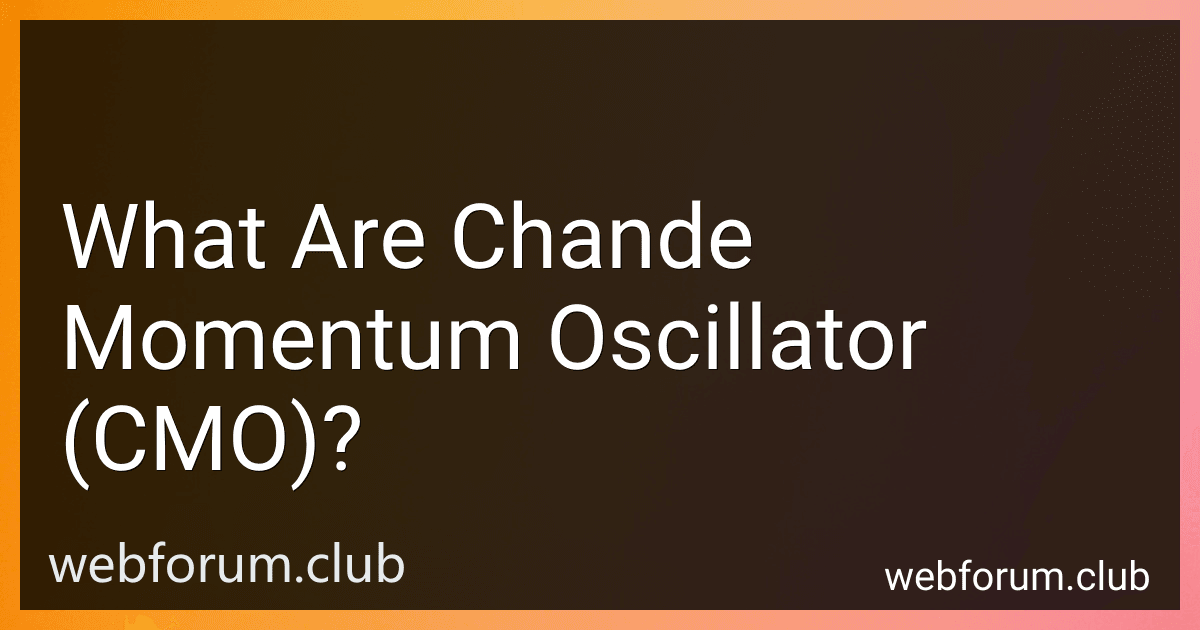The Chande Momentum Oscillator (CMO) is a technical analysis indicator developed by Tushar Chande, a renowned quant trader and author. It measures the momentum of a financial instrument by calculating the difference between the sum of gains and the sum of losses over a specific period.
Unlike other momentum oscillators that use traditional price changes, the CMO uses the concept of "accumulative swing index" to determine price momentum. It aims to identify overbought and oversold conditions in the market and generate potential buy/sell signals.
The CMO is computed using the following formula: CMO = 100 * ((Sum(Gains) - Sum(Losses)) / ((Sum(Gains) + Sum(Losses))), where Gains represent upward price movements and Losses represent downward price movements.
The oscillator typically ranges from -100 to +100, with extreme values indicating overbought and oversold conditions. Values above +50 are considered bullish, while values below -50 are considered bearish. Traders often look for divergences between the CMO and price movement as signals to anticipate trend reversals.
Furthermore, the CMO can also be used to spot potential entry or exit points based on overbought/oversold conditions. Traders often employ additional technical analysis tools, such as trendlines or moving averages, to improve the accuracy of their trading decisions.
It is important to note that while the Chande Momentum Oscillator can be a useful tool, it should not be solely relied upon for making trading decisions. It should be complemented with other indicators and analysis techniques to ensure a comprehensive assessment of market conditions.
How does Chande Momentum Oscillator (CMO) work?
The Chande Momentum Oscillator (CMO) is a technical analysis tool that measures the momentum of a security by comparing its current price to its previous price over a given period. It was developed by Tushar Chande.
The CMO calculates the difference between the sum of all positive price changes and the sum of all negative price changes over the chosen period. It then normalizes these differences by dividing the absolute difference by the sum of all price changes and multiplying the result by 100.
Here are the step-by-step calculations for the CMO:
- Calculate the price change for each period: Price Change = Today's Price - Previous Price
- Separate the positive and negative price changes.
- Sum all positive price changes: SumPositive = Sum of All Positive Price Changes
- Sum all negative price changes: SumNegative = Sum of All Negative Price Changes
- Calculate the raw CMO: Raw CMO = ((SumPositive - SumNegative) / (SumPositive + SumNegative)) * 100
The resulting CMO value will oscillate around zero. A positive CMO indicates bullish momentum, while a negative CMO suggests bearish momentum. Traders can look for CMO values crossing above or below specific thresholds (e.g., +50 or -50) as potential buy or sell signals.
The CMO can help identify overbought or oversold conditions, bullish or bearish divergences, and potential trend reversals. Additionally, it can be used in combination with other technical indicators and price patterns to generate trading signals and confirm market trends.
What is Chande Momentum Oscillator (CMO)?
The Chande Momentum Oscillator (CMO) is a technical analysis tool that measures the momentum of a financial instrument. It was developed by Tushar Chande and is based on the premise that momentum precedes price movements.
The CMO calculates the difference between the sum of positive and negative price changes over a given period of time. It then normalizes this difference by dividing it by the sum of all price changes over the same period. This results in a value that oscillates between -100 and +100.
Traders use the CMO to identify overbought and oversold conditions in a market. Readings above +50 are considered overbought, indicating that the asset's price may be due for a reversal or a correction. Conversely, readings below -50 are considered oversold, suggesting that the price may be primed for a bounce or a bullish reversal.
Additionally, traders may look for divergences between the CMO and the price of the asset. For example, if the price is making higher highs while the CMO is making lower highs, it could signify a bearish divergence and a potential reversal in the price trend.
The CMO can be applied to various timeframes and can be used in conjunction with other technical indicators and chart patterns to make more informed trading decisions.
What are the different variations or modifications of Chande Momentum Oscillator (CMO)?
There are several variations or modifications of the Chande Momentum Oscillator (CMO) that have been developed over time. Some of the popular variations include:
- Weighted Chande Momentum Oscillator: This variation assigns different weights to different periods of price data, giving more importance to recent price movements.
- Smoothed Chande Momentum Oscillator: In this modification, a moving average is applied to the CMO values to remove some of the noise and provide a smoother indicator line.
- Normalized Chande Momentum Oscillator: This version of CMO scales the values between 0 and 100, making it easier to compare across different securities or timeframes.
- Adaptive Chande Momentum Oscillator: This modification adjusts the period of the CMO based on market conditions, aiming to provide more accurate signals in different market environments.
- Double Smoothed Chande Momentum Oscillator: This variation applies a double smoothing technique to the CMO, resulting in a slower and more stable indicator line.
- Fractal Chande Momentum Oscillator: This modification combines the CMO with fractal analysis techniques to identify potential turning points and reversals in the market.
It is important to note that these variations may have different formulas and calculation methods, so users should refer to the specific implementation or version they are using to understand how it is calculated and interpreted.
